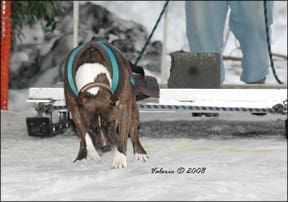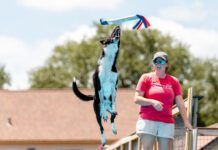[Updated July 19, 2017]
CANINE WEIGHT PULL OVERVIEW
What is this sport? In weight pulling, a dog‘s strength and stamina are tested by his ability to pull weights.
Prior training required? Moderate.
Physical demands? On the dog: Moderate to high. On the handler: Minimal.
Best-suited structure? Dogs of all sizes and shapes can compete, although the bully breeds do best.
Best-suited temperament? Dogs who enjoy working with their owners.
Cost? Minimal.
Training complexity? Minimal.
Mental stimulation? Moderate.
Physical stimulation? High.
Recreational opportunities? Low.
Competition opportunities and venues? Moderate.
Work it! Work it! Work it! Leaning into the padded harness, muscles bulging with effort, eyes dark with determination, inch-by-inch, the American Staffordshire Terrier pulls the cart loaded with 60-pound pieces of railroad track toward her owner. This is Duvall’s Sureshot Kamakazi, “Banzai,” a striking 43-pound, 17-inch brindle girl. Her owner, Karyn Dawes, smiles wide as she realizes that Banzai is going to record a new “personal best.” It’s official: 3,900 pounds and 90.7 times her body weight. What a gal! Banzai wiggles in delight at Karyn’s hug and effusive praise for a job well done.

In 2003 when Dawes discovered the sport of weight pulling, she had no idea she and her dogs would enjoy it so much. She was an experienced dog sport aficionado, having competed in obedience, Schutzhund, flyball, agility, and carting. It was only at the insistence of a good friend that she capitulated and gave pulling a try. Like many neophytes to a sport, she made a lot of mistakes at the beginning, and then went on to put titles on 11 dogs.
“My first time was cold turkey,” Dawes recalls. “No training, no practice. I borrowed a harness just for fun to see what the dog would do. You’d think by now I would know better! My dog pulled a qualifying pull the first day. The second day she ‘told’ me that if I want to do this sport, she would like me to invest some time in training and conditioning. In other words, I got the ‘paw.'”
Weight Pull History
Dogs have pulled sleds and carts for humans throughout history. In small towns around the world, owners proudly boasted of how strong their dogs were, how much they could pull and how far. “Yeah? You wanna bet? My dog can pull more than your dog!” That’s probably how the sport of weight pulling started. Now there are several organizations that have established rules and regulations for formal competition.
Although any breed can enjoy this sport, it is one that commonly attracts more “bully” breeds (such as American Staffordshire Terriers, Bulldogs, Mastiffs, Boxers, etc.) than any other breed. Some of the sanctioning organizations limit their competitions to purebred dogs while others are open to all dogs.
The United Kennel Club (UKC) rules of competition reflect the goals of most weight pulling competitions, which is to demonstrate a dog’s stamina and strength. In brief, each dog is given 60 seconds to pull the most weight that he can in a 16-foot “chute.” Dogs are separated into “classes” based on their body weight. Dogs who pull a larger percentage of their body weight earn the most points.
The dog wears a padded harness, which is attached to a “trace,” which connects to a “weighted vehicle” that is loaded with sand bags or other easily weighed objects. There are three different types of vehicles.
- Sleds are pulled on natural or artificial snow and must be able to carry a minimum of 3,000 pounds.
- Double-axel wheeled carts are pulled on carpet and must be able to carry at least 5,000 pounds.
- Rail carts are pulled along a rail system and must be able to carry at least 6,000 pounds (the dogs’ path is carpeted so they can achieve traction when pulling).
The chute that contains the pulling system is 35 feet long and between 10 and 20 feet wide.
Canine Weight Pull Titles
There are several titles available in the UKC system. These are just some of them:
- United Weight Puller (UWP): Three qualifying pulls are required. These can be all using the same type of weight vehicle or a combination of the three different vehicles. Each of the different vehicles has a different weight requirement. For example, a dog pulling a sled must pull 3 times his body weight; a dog on rails must pull 10 times his body weight; and a dog pulling a cart must pull 8 times his body weight. You must have the UWP title before pursuing the various championship titles.
- United Weight Pull Champion (UWPCH): Once this level of competition is reached, the competitor starts earning points toward the UWPCH title. 100 points are required for the UWPCH.
- United Weight Pull Champion Excellent (UWPCHX): 250 points are required for this title.
- United Grand Weight Pull Champion (UGWPCH): The dog must have completed the UWPCHX title before earning the additional 200 points for this title.
- United Grand Weight Pull Champion 1 (UGWPC1): The dog must have completed the UGWPCH before earning the additional 200 points for this title.
The somewhat complicated point system is described in detail on the UKC website. Generally, points are earned for the higher levels of competition based on placements (first through fourth place) and the type of vehicle pulled. For example, dogs pulling on wheels earn 20 points for pulling 35 times their body weight, 15 points for 25 times their body weight, 10 points for 15 times their body weight, and 5 points for 10 times their body weight. There are also bonus points awarded for dogs who pull the most weight and the most weight per body weight at each competition. Additional titles require a dog to pull a combination of different vehicles.

There are annual “All Star” rankings based on points earned throughout the year. The rankings are broken into three classes: 1) American Pit Bull Terrier; 2) American Bulldog; and 3) Multi-breed (all other breeds). For dogs who show in conformation as well as weight pulling, there is also a Total Dog Award that can be earned at individual shows by qualifying in a performance sport and taking one of the “winners” awards in conformation on the same day.
Training
Basic pet manners training provides a good foundation for the sport of weight pulling. Your dog needs to be under control and to have been adequately socialized with people and other dogs in order to be comfortable in a competitive environment. That said, weight pulling does not require extensive training. What it does require is the human on the other end of the leash to very gradually physically condition her dog before asking him to pull larger and larger percentages of his body weight.
Dawes, who has trained and titled 11 dogs in the sport, starts by introducing the harness first. “I put the harness on and do short walks with plenty of treats and encouragement. I make sure to hold the spreader bar at the back of the harness so it does not bang the back of the dog’s legs. ‘Drag training’ starts with a plastic bottle filled with small rocks. This is not heavy. Its main purpose is to get the dog used to something noisy following behind. Next I introduce an empty sled. This weighs about 15 pounds. We do lots of praise and rewarding – not luring – but rewards for short distances.”
Experienced handlers know that luring or “baiting” a dog to pull might cause the dog to pull more than he is physically or mentally prepared for. Under the rules of most sanctioning organizations (there are exceptions), handlers are not allowed to use lures or bait during a competition. Although treats are used, they are used to reward the dog for short-distance pulls and gradually increasing weight loads.
“As the dog becomes familiar with the job, I increase the amount of weight and vary the training,” says Dawes. “For example, I might use a heavier weight for short distances and a lighter weight for longer distances. Most of the actual training is done with a sled as few people own their own wheel or rail systems. Occasionally, club members will get together to work their dogs on the actual competition pulling equipment.”
Many people join clubs and train and practice together. Dawes joined her friend’s club, Rip Curl Weight Pullers, and got a lot of help from other members over the years. She now helps newcomers and provides private instruction, as do some of the other club members. The club occasionally offers seminars, but members feel that the real benefits of the club are the camaraderie and support they get from one another.
“We are all enthusiastic about the sport and are always willing to answer questions and give people tips to help them start. When we hold pulls, we encourage people to come without their dog and observe. Once you understand the basics, it’s pretty much a matter of training and conditioning on your own. Just remember: be patient and never forget that the dog did not sign on for the job. You chose the sport; the dog did not. Dogs have good and bad days. Keep your training positive and respect your dog.”
To find a club in your area, go to the UKC website.
Canine Weight Pull Team Attributes
Many who are attracted to dog sports cite the strong relationship that results from the time training and playing together. Weight pulling is no different. “Like any of the dog sports when I ask ‘what’s in it for the dog,’ I have to first point to the quality and quantity of time we spend together,” says Dawes. “Training for anything builds a strong relationship. Some dogs really love the sport. Most work to please their owner. Unfortunately, there are a few people who still use aversive training methods (something that our group does not endorse). You can tell which dogs are trained this way as they walk onto the track.
“Weight pull is work! So, unlike agility or flyball, where the dog barks, jumps, and runs (all things most dogs inherently enjoy), the dog must want to work for the owner or rewards at the end of the pull. There are some dogs who really love pulling, but I would say that most pull to please their handlers.”

The sport attracts many of the “bully” breeds, but Dawes has seen, among others, Great Danes, Rat Terriers, Cattle Dogs, Black and Tan Coonhounds, Basenjis, Patterdale Terriers, Boston Terriers, Shelties, and even an Italian Greyhound. “This sport is mental as much as it is physical. If you capture the dog’s mind, their doggy body will follow. It’s a bit like ‘The Little Engine That Could’ – if they think they can, dogs can do some amazing things.”
People who love this sport come from all walks of life. In the Rip Curl Weight Pullers Club there is a veterinary technician, a groomer, a paramedic, retirees, a heavy equipment operator, and Dawes, who is currently a booking agent for a pet transport company. Prior to finding satisfaction making sure pets arrive safely, she was an advertising sales and layout designer for an aviation newspaper.
Club members may participate in a variety of dog sports although some concentrate all their efforts on this one. “There is the element I refer to as the ‘heavy hitters’ whose only sport is weight pull. These folks parallel the obedience folks who are after the 200 score or the agility people who are aiming for the World Team.”
Equipment and Expenses
Equipment costs are minimal for basic training and conditioning, but you’ll need to join a club unless you want to assume the cost of and find the space for a pulling system. As a member of a weight pulling club, this sport is pretty inexpensive. When you can find someone to instruct you on a private basis, expect to pay around $40 per session. A custom harness for your dog will cost around $75. Entry fees for competition cost about $25.
Get Started!
You might be surprised when you learn that your dog enjoys a sport that results in so much hard work for him. But, with the right animal magnetism, you just might convince him that you’re worth it.
Terry Long, CPDT-KA, is a writer, agility instructor, and behavior counselor in Long Beach, CA. She lives with four dogs and a cat and is addicted to agility and animal behavior.







I’m looking to buy a good weight vest for my pit bull to help with his weight pulling conditioning
I’m a little late but I’m wondering when working the dog out. Should I have him do reputations like I would do working out 4 sets of 10 reputations , would I do something like this for my dog training. Do you have any web sites I can go to ,I’m about to start my dog up,I need to learn how and what to do before I even put the harness on him . Thank you for even reading this . My name is Murray.